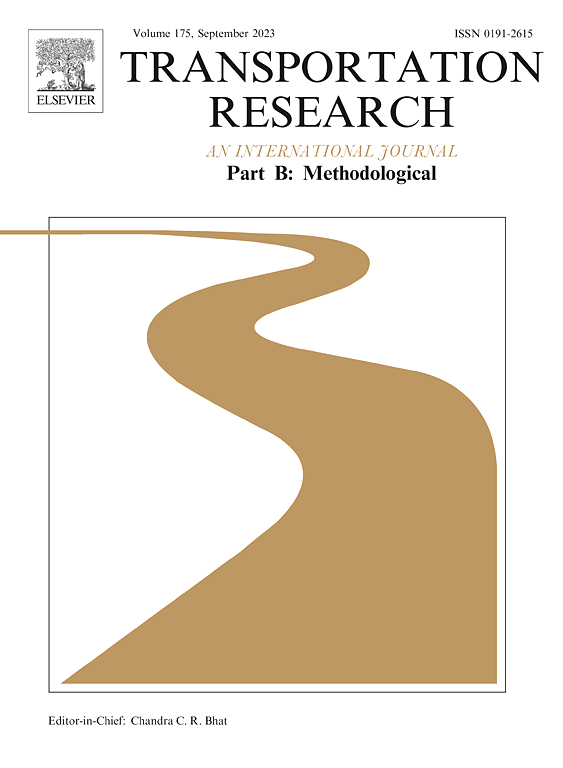都市圈端到端物流:一个随机动态订单分配与调度问题
IF 6.3
1区 工程技术
Q1 ECONOMICS
引用次数: 0
摘要
电子商务的发展需要第一英里提货、中间英里整合和最后一英里配送的高效整合。这些所谓的一体化端到端物流业务在快速配送服务需求旺盛的大都市地区尤为明显。受我们的行业合作伙伴的实际实践启发,本文介绍了随机动态顺序分配和调度问题(SDOA-DP)。它涉及端到端物流配送平台上产生的随机动态取货订单,作为决策者的公司需要实时确定如何将订单分配到中间一英里的线路运输计划中,以及何时调度第一英里和最后一英里的两级车辆路线。我们将SDOA-DP建模为一个马尔可夫决策过程,并提出了一种新的解决方法,该方法基于参数化成本函数近似(CFA)用于中间英里的订单分配和参数化自适应大邻域搜索(ALNS)用于车辆调度和第一英里和最后一英里的两级路由。CFA平衡了使用线路的成本和第一英里和最后一英里计划的空闲时间,同时确保满足时间窗口。ALNS中的参数化通过限制调度车辆路线的频率和时间,保证了调度成本和配送速度的平衡。我们用贝叶斯优化来学习参数化的最佳值。计算实验表明,与基线策略相比,我们的方法产生了平均22%的改进。如果我们为不同的系统设置学习一个单一的最佳参数化,我们观察到几乎同样好的成本节约,表明我们的方法对于从业者来说是健壮和可靠的。最后,我们将我们的方法应用到我们的行业合作伙伴的案例研究中,并表明我们的方法可以在各种操作环境中潜在地减少30.5%的日常成本。本文章由计算机程序翻译,如有差异,请以英文原文为准。
End-to-end logistics in metropolitan areas: A stochastic dynamic order-assignment and dispatching problem
The growth of e-commerce requires efficient integration of first-mile pickup, middle-mile consolidation, and last-mile delivery. These so-called integrated end-to-end logistics operations are particularly visible in metropolitan areas where fast delivery services are in high demand. Inspired by real-world practices at our industry partner, this paper introduces the Stochastic Dynamic Order-Assignment and Dispatching Problem (SDOA-DP). It concerns stochastic and dynamic pickup-and-delivery orders arising at an end-to-end logistics delivery platform, for which the company, as a decision maker, needs to determine in real-time how to assign orders to middle-mile linehaul schedules and when to dispatch first- and last-mile two-echelon vehicle routes. We model the SDOA-DP as a Markov Decision Process and propose a novel solution approach based on a parameterized Cost Function Approximation (CFA) for order assignment in the middle mile and a parameterized Adaptive Large Neighborhood Search (ALNS) for vehicle dispatch and two-echelon routing in the first and last-mile. The CFA balances the cost of using linehauls with the time slack available for first- and last-mile planning while ensuring time windows are met. The parameterization in the ALNS ensures that we balance routing cost and delivery speed by limiting the frequency and timing of dispatching vehicle routes. We learn the best value of the parameterization using Bayesian optimization. Computational experiments show that our approach yields a 22% on-average improvement compared to a baseline policy. If we learn a single best parameterization for various system settings, we observe almost as good cost savings, showing that our approach is robust and reliable for practitioners. Finally, we applied our method to a case study of our industry partner and showed that our method could potentially reduce daily costs by 30.5% across various operational contexts.
求助全文
通过发布文献求助,成功后即可免费获取论文全文。
去求助
来源期刊
CiteScore
12.40
自引率
8.80%
发文量
143
审稿时长
14.1 weeks
期刊介绍:
Transportation Research: Part B publishes papers on all methodological aspects of the subject, particularly those that require mathematical analysis. The general theme of the journal is the development and solution of problems that are adequately motivated to deal with important aspects of the design and/or analysis of transportation systems. Areas covered include: traffic flow; design and analysis of transportation networks; control and scheduling; optimization; queuing theory; logistics; supply chains; development and application of statistical, econometric and mathematical models to address transportation problems; cost models; pricing and/or investment; traveler or shipper behavior; cost-benefit methodologies.

 求助内容:
求助内容: 应助结果提醒方式:
应助结果提醒方式:


